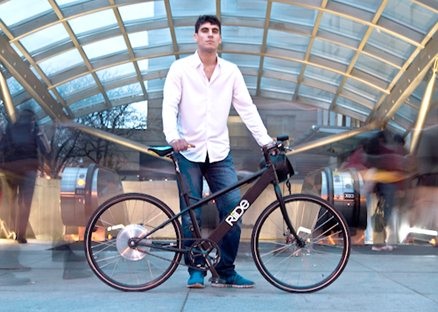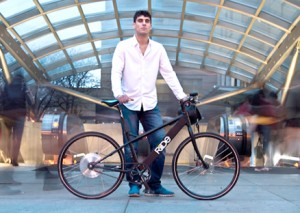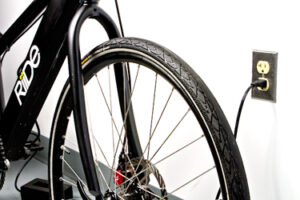
By Nancy Arsenault

Sometimes it just takes a really great idea….and extremely good instincts, personal determination and the support of enthusiastic financial backers. Stow native and 2009 Nashoba High School graduate Jeff Stefanis has all of that and more. He and business partner Amber Wason are about to hit the market in May with America’s newest and most unique electric bicycle, or e-bike; the initial product offered by Riide, a company he and Wason founded to change the face of urban commuting in the United States.
While a student at Georgetown University, before graduating last May, Stefanis’s entrepreneurial spirit was evident, crafting his own major – Entrepreneurship in Energy Studies. It was during these years in Washington DC that he came to love city life, but not the hassles of urban traffic and commuting.
A trip to China introduced him to the concept of e-bikes – bicycles outfitted with motors that helped propel commuters longer distances and in some cases, with less effort, than traditional bicycles. While commonplace in Asia and Europe, e-bikes introduced in America had not really taken hold, until, according to Stefanis, commuter bikers in Washington, DC took a test spin on his Riide prototype.
The initial enthusiasm shown by Riide’s focus group participants in the nation’s capital propelled the duo to list their project on crowd funding site Kickstart, hoping to raise $50,000 to begin the evolution of their prototype into a manufactured reality. In less than a day, their fundraising goal was met. In just 40 days, they more than doubled the hoped for amount, sending the two out to find sources for component materials and fine tune their design.
“Before we even went forward with Kickstart, we spent 18 months researching and finding out what would make the best e-bike,” explained Stefanis. That research has paid off for the Riide co-founders. According to a slew of press reports within the energy, transportation and cycling worlds, the Riide e-bike is like no other that has come before it.
So what is an e-bike? It is a bicycle that in every way looks like a traditional bicycle, except that it has a battery powered motor as part of its makeup, allowing users to travel farther, with less effort than can be achieved from just pedaling.
Stefanis’ Riide design incorporates a unique throttle lever allowing riders to increase speed with direct control according to terrain and traffic conditions. While the bikes can achieve motorized speeds of 20mph, Stefanis said that under all speed options, the bike can still accommodate accompanying pedaling motion.
The Riide has a 25-mile range before needing a 2-3 hour recharge from a simple wall outlet. The motor is nearly silent. The Riide is considered a bike, not a scooter, so it does not require licensing or registration. Riders of e-bikes, however, must still abide by the rules of the road associated with traditional bicycles. “This bike is designed not primarily for exercise, but for transportation and ease of use,” said Stefanis.
The price point is about $1800, which puts it well below the $3000-4000 price tags of other e-bikes, said Stefanis, or about $3/day, less than the cost of public transportation just about anywhere. But that is only the start of the differences. European e-bikes, in particular, are propelled by a 40lb motor/battery combination attached to the rear wheel, creating a heavy, dragging feel as one tries to move forward, said Stefanis. “It doesn’t feel like a bike,” he said of the eventual 70 lb weight of those contraptions. His innovation is powered by a 4lb motor/battery streamlined inside the tube between the handlebars and center frame, creating a relatively lightweight 40 lb bicycle.

Testing the Market
Stefanis’s research determined that existing e-bikes have gear and derailleur mechanisms similar to traditional bikes, but that no one ever seemed to switch gears. “Those are parts that most often break down. We don’t have gears or derailleurs,” said Stefanis. When the motor is not engaged, the bike can go as fast as its rider wishes to pedal, yet the motor is ready at any time with a quick twist of the throttle. Braking actions send energy back to recharge the battery while the bike remains in motion.
Another special feature speaks directly to today’s urban and electronically connected bike commuter. A Smartphone mount on the handlebars puts GPS mapping and cycling apps in front of the rider, eliminating the need to stop and check physical maps or electronic directions on a pocket device.
Stefanis said they selected the highest quality parts manufacturers, especially for the battery, which has a lifespan of 1800 cycles, or 40,000 miles. A two-year warranty on all electronic parts is standard with every Riide bike.
Stefanis admitted that he and partner Wason are still slightly amazed at their own success. “We are a little baffled that no one else had come up with these ideas,” he said. In fact, their idea is so personal, that while they did consult experts in various areas of manufacture and cycling, the final design for the bike is all theirs. “We ended up teaching ourselves a lot of physics and bike mechanics, and in the end, yes, we designed it ourselves,” he said.
Sixty-five pre-orders have been placed on their company website Riide.com and, after assembly, will be distributed in time for spring. Stefanis is planning a trip home to Stow in the next few months, when he will be offering test rides on a Riide e-bike, most likely in the parking lot of his father’s Stow Gardens shop on Great Road.